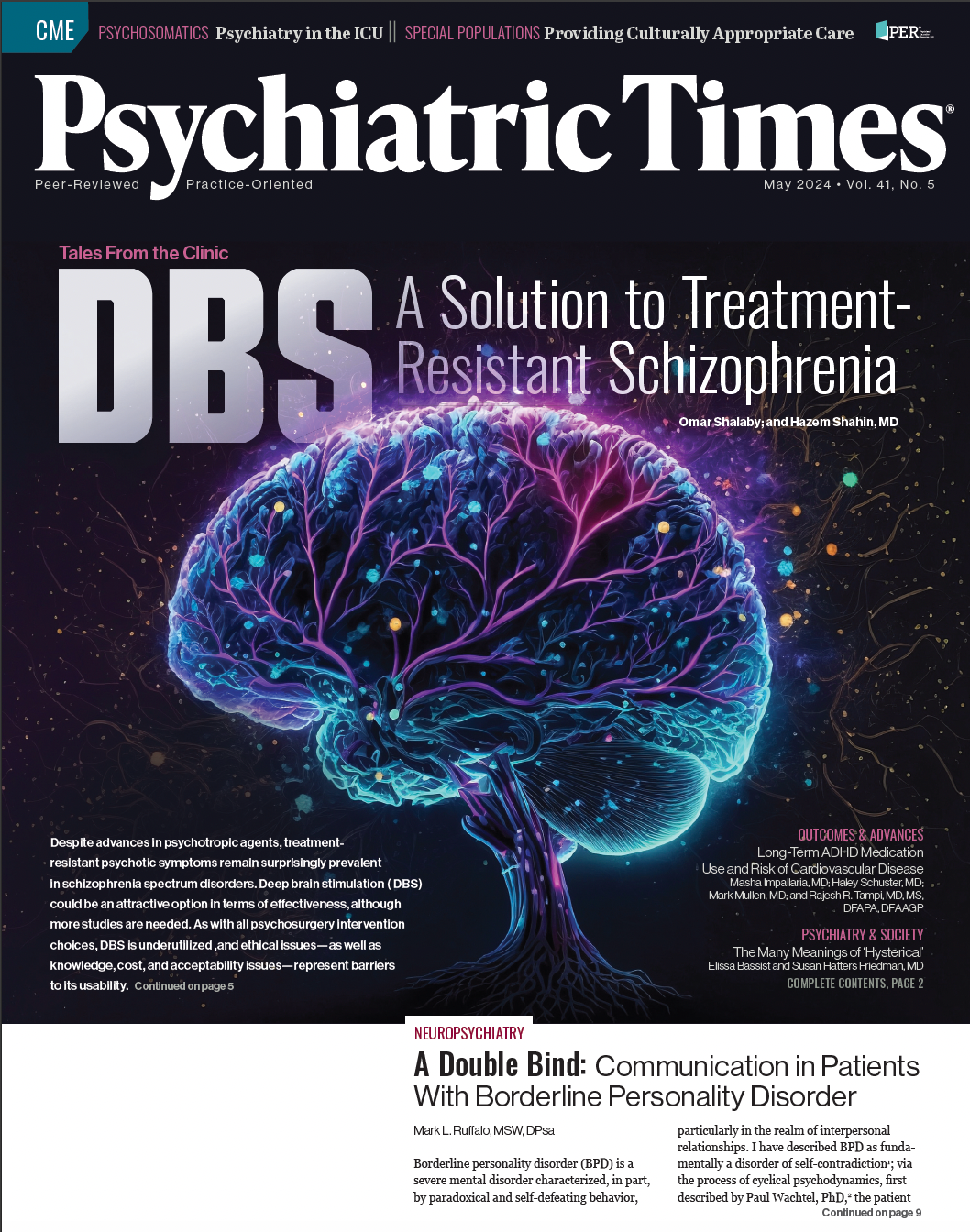News
Article
Psychiatric Times
Correlates of Antipsychotic Polypharmacy in Taiwanese Patients With Schizophrenia
Author(s):
What are the risks and benefits of antipsychotic polypharmacy for the treatment of schizophrenia?
James Thew_AdobeStock

SPECIAL REPORT: POLYPHARMACY
CASE VIGNETTE
“Mr Shen” is a 52-year-old Asian man with a history of chronic schizophrenia. The onset of his psychotic disorder was at age 21 years. Previous trials of aripiprazole and olanzapine were not successful. He is currently taking haloperidol decanoate 150 mg via intramuscular injection monthly and quetiapine 600 mg by mouth every night, and has done so for several years. He has seen the same outpatient psychiatrist for the past 7 years. This psychiatrist did not initiate, but has continued, antipsychotic polypharmacy.
Mr Shen and his mother state that he began taking both these medications during a psychiatric hospitalization years ago. They are reluctant to change his medications because he has not required psychiatric hospitalization for more than a decade.
He still has intermittent auditory hallucinations, and his mother states Mr Shen will sometimes talk to the television. His thought process is mildly disorganized at times. He has mild to moderate residual negative symptoms. He has never attempted suicide, and there is no history of substance use disorder. He does not take any other psychotropic medications. His only other medication is lisinopril for hypertension.
His most recent laboratory results show that fasting glucose and lipid levels are within normal limits. As his psychiatrist, how would you manage his antipsychotic medications?
Although treatment guidelines recommend antipsychotic monotherapy for patients with schizophrenia,1 at least 20% of patients have a partial response or nonresponse to this approach.2
Antipsychotic polypharmacy (APP)—the concurrent use of 2 or more antipsychotics—is a widely used strategy for patients with inadequate response to antipsychotic monotherapy (AMT) and/or to address illness exacerbations, negative symptoms, violence, anxiety, and insomnia.3
Nevertheless, findings on the risks and benefits of APP are inconsistent,4,5 although there is some evidence that APP may be a viable option in the acute phase of treatment for patients who do not respond to AMT.6
However, APP may also be associated with an increased risk of adverse effects, drug-drug interactions, and adherence issues. Practice guidelines suggest using APP only for patients with treatment-resistant schizophrenia, after multiple antipsychotics trials, including clozapine.1
The Current Study
Lin et al aimed to determine rates of factors associated with and temporal trends in APP, as well as whether APP affects time to rehospitalization within 1 year of discharge.7 The authors performed a retrospective cohort study of Kaohsiung Municipal Kai-Syuan Psychiatric Hospital, a public mental health hospital in southern Taiwan. They extracted data through chart review and electronic medical records.
Cohort members were individuals with DSM-IV-TR or DSM-5 schizophrenia or schizoaffective disorders (diagnosed by board-certified psychiatrists), discharged with antipsychotics between 2006 and 2021. Individuals who were not prescribed antipsychotics and discharged, were discharged against medical advice, or participated in a clinical trial during the study period were excluded. After discharge, patients were followed in the outpatient clinic at Kai-Syuan Psychiatric Hospital.
AMT was defined as a single oral or long-acting injectable (LAI) antipsychotic, or the oral and LAI forms of the same antipsychotic. Antipsychotic doses were converted into chlorpromazine equivalents. APP was divided into 3 groups: (1) combinations of 2 first-generation antipsychotics (FGAs), (2) combinations of 2 second-generation antipsychotics (SGAs), and (3) SGA and FGA combinations. Biperiden and trihexyphenidyl were used to treat extrapyramidal adverse effects.
Logistic regression models were used to compared clinical variables—sex, LAI use, clozapine use, anticholinergic use, age, age of illness onset, previous hospitalizations, length of hospitalization, and chlorpromazine equivalents—between the APP and AMT groups. Cox proportional hazards multivariate regression was used to compare time to rehospitalization between the APP and AMT groups, as well as between the 3 APP groups. The Cochran-Armitage trend test was used to evaluate time trends in APP prescription rates from 2006 to 2021.
During the study period, 18,840 patients were discharged and 16,722 were included in the analysis. The mean participant age was 46 years, 57% of patients were male, and the mean length of hospital stay was 178 days. Approximately 35% of discharged patients received APP and 65% received AMT. The average chlorpromazine equivalents were 581 mg/day for APP and 306 mg/day for AMT.
The most commonly used FGAs were haloperidol, chlorpromazine, and sulpiride. The most common SGAs were risperidone, clozapine, and quetiapine. In patients receiving APP, 63% of therapies were FGA-SGA, 19% were SGA-SGA, and 18% were FGA-FGA.
After controlling for potential confounders, APP was significantly associated with male sex, LAI use, clozapine and anticholinergic use, more previous hospitalizations, and an increased chlorpromazine-equivalent dose. Patients in the APP group (66%) vs AMT group (61%) had a significantly higher rate of rehospitalization (adjusted HR, 1.08) and a shorter time to rehospitalization (median, 93 vs 113 days, respectively). Among different APP groups, there were no significant differences in time to rehospitalization. There was a significant time trend of increasing APP prescription, rising from 18% in 2006 to 45% in 2021.
Study Conclusions
The authors concluded that APP was common among patients with schizophrenia (35%), which may reflect more aggressive therapeutic efforts for patients with treatment resistance, as patients receiving APP were at increased risk of rehospitalization within a year of discharge. There was also a significant time trend of increasing APP prescription, rising from 18% in 2006 to 45% in 2021.
Study strengths included a large sample size, consideration of many predictor variables, longitudinal analysis, and use of effectiveness data. Study limitations included nonrandomized treatment allocation, diagnoses based on clinical judgment (vs standardized interviews), focus on patients recently discharged from an inpatient psychiatric hospital, absence of data on symptom severity and adherence, and the use of an all-Taiwanese sample.
The Bottom Line
APP is commonly prescribed for patients with schizophrenia in Taiwan and with an increasing frequency. APP was associated with more clozapine and LAI use, as well as higher total antipsychotic dose. APP did not decrease the risk of rehospitalization. Further studies should investigate whether specific APP combinations can reduce the risk of rehospitalization.
Dr Miller is a professor in the Department of Psychiatry and Health Behavior, Augusta University, Georgia. He is on the Editorial Board and serves as the schizophrenia section chief for Psychiatric Times. The author reports that he receives research support from Augusta University, the National Institute of Mental Health, and the Stanley Medical Research Institute.
References
1. Keepers GA, Fochtmann LJ, Anzia JM, et al, eds. The American Psychiatric Association Practice Guideline For the Treatment of Patients With Schizophrenia. 3rd ed. American Psychiatric Association; 2021
2. Samara MT, Nikolakopoulou A, Salanti G, Leucht S. How many patients with schizophrenia do not respond to antipsychotic drugs in the short term? An analysis based on individual patient data from randomized controlled trials. Schizophr Bull. 2019;45(3):639-646.
3. Pae CU. Antipsychotic polypharmacy in treatment of schizophrenia; should or should not? Chonnam Med J. 2020;56(3):157-165.
4. Correll CU, Gallego JA. Antipsychotic polypharmacy: a comprehensive evaluation of relevant correlates of a long-standing clinical practice. Psychiatr Clin North Am. 2012;35(3):661-681.
5. Lähteenvuo M, Tiihonen J. Antipsychotic polypharmacy for the management of schizophrenia: evidence and recommendations. Drugs. 2021;81(11):1273-1284.
6. Hatta K, Hasegawa H, Imai A, et al; JAST study group. Real-world effectiveness of antipsychotic monotherapy and polytherapy in 1543 patients with acute-phase schizophrenia. Asian J Psychiatr. 2019;40:82-87.
7. Lin CH, Huang CJ, Lin TC, et al. Schizophrenia patients discharged on antipsychotic polypharmacy from a public psychiatric hospital in Taiwan, 2006–2021. Psychiatry Res. 2023;330:115575.

Newsletter
Receive trusted psychiatric news, expert analysis, and clinical insights — subscribe today to support your practice and your patients.






